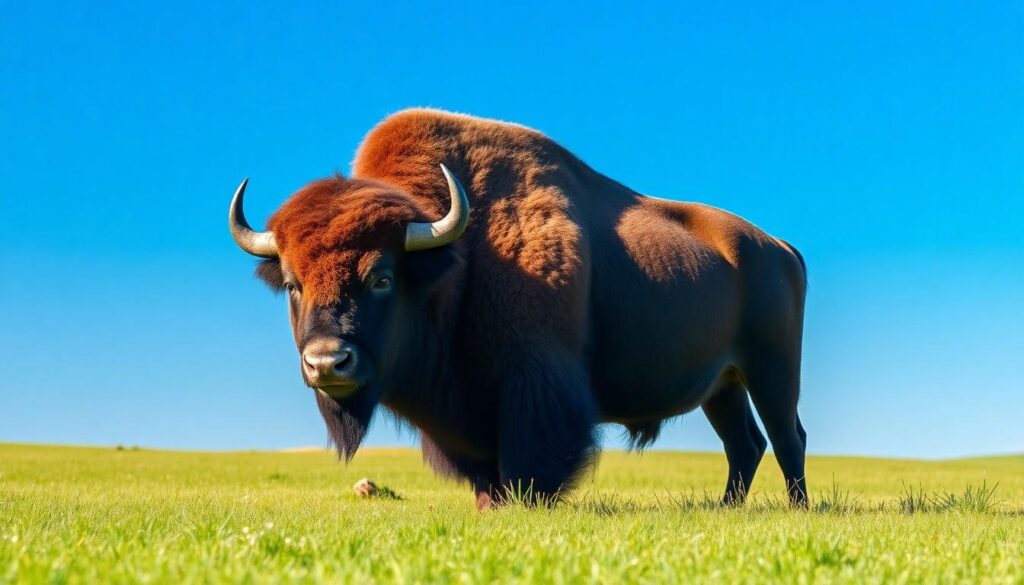Bison, the majestic giants of North America, deserve names that capture their power and presence. Whether you’re looking to name a pet, character, or simply curious about these magnificent creatures, finding the perfect bison name can be both fun and meaningful.
We’ve gathered an extensive collection of bison names inspired by Native American languages, historical references, and the animal’s distinctive characteristics. From traditional names honoring their cultural significance to creative options that highlight their strength and resilience, our list has something for everyone. Let’s explore these powerful names that pay tribute to one of America’s most iconic wildlife symbols.
10 Mighty Male Bison Names With Historical Significance
- Tatanka – This powerful name comes from the Lakota language and literally means “buffalo” or “bull buffalo.” Tatanka held deep spiritual significance among many Plains tribes and was famously used in reference to Sitting Bull, whose name in Lakota was Tatanka Iyotake.
- Bison – The original Latin word that gave us our modern term for these magnificent creatures makes for a straightforward yet commanding name. During the 18th century, naturalists established this scientific classification that distinguishes American bison from other bovines.
- Thunder – Reflecting the sound of massive bison herds moving across the plains, this name captures the awe-inspiring power early pioneers experienced. Historical accounts describe the ground trembling like thunder as millions of bison traveled together.
- Tatonka – A variation of the Lakota word for buffalo, this name features prominently in Native American storytelling and cultural traditions. Medicine men would often invoke Tatonka during healing ceremonies and important tribal rituals.
- Cody – Named after William Frederick “Buffalo Bill” Cody, the famous American scout and showman who earned his nickname for his buffalo-hunting prowess. His Wild West shows in the late 1800s brought bison to international attention.
- Toro – Spanish for “bull,” this name connects to the early Spanish explorers who encountered bison in the American Southwest. Spanish documents from the 16th century record their amazement at the “fierce bulls” roaming the plains.
- Chief – Honoring the leadership role of dominant male bison in their herds, this name carries historical weight. Native American tribes often compared their tribal chiefs to the lead bulls that guided and protected the herd.
- Dakota – Meaning “ally” or “friend” in the Dakota Sioux language, this name honors the deep relationship between bison and the Sioux nations. The Dakota people built their entire way of life around seasonal bison migrations.
- Geronimo – Named after the famous Apache leader who resisted American expansion, this name represents strength and resistance. Like the bison that survived near-extinction, Geronimo’s legacy embodies resilience against overwhelming odds.
- Quanah – Honoring Quanah Parker, the last chief of the Comanche tribe and son of captive Cynthia Ann Parker. His leadership during the difficult transition period when bison populations were decimated mirrors the resilience of these magnificent animals.
12 Beautiful Female Bison Names Inspired By Nature

Choosing the perfect name for a female bison means capturing her majestic presence and connection to the wild landscapes she inhabits. We’ve gathered some stunning nature-inspired names that reflect the natural habitats these magnificent creatures call home.
Prairie-Inspired Female Bison Names
Prairie perfectly embodies the vast grasslands where bison roam freely across North America. Meadow reflects the lush grazing areas that sustain bison herds throughout the seasons. Willow brings to mind the graceful trees often found near water sources frequented by bison. Dakota connects to the Great Plains region where American bison thrived for centuries before near-extinction. Sage represents the aromatic plants covering the prairie landscapes that form part of the bison’s natural diet. Lark honors the birds that often accompany bison herds across the grasslands. Skye captures the endless horizon that stretches above the open plains where bison travel. River signifies the vital waterways that sustain prairie life and bison migrations.
Mountain-Inspired Female Bison Names
Sierra recalls the majestic mountain ranges that some bison populations navigate during seasonal movements. Aspen symbolizes the distinctive trees found in higher elevations where mountain bison seek summer grazing. Rocky pays homage to the mountain terrain that challenges and strengthens these powerful animals. Alta means “high” in Latin, representing the elevated habitats some bison populations occupy. Canyon reflects the dramatic landscapes carved by water where bison find shelter and resources. Denali references North America’s highest peak, matching the bison’s status as the continent’s largest land mammal. Glacier evokes the cool mountain environments bison have adapted to throughout their evolutionary history. Terra connects these magnificent animals to the earth they help maintain through grazing and migration patterns.
15 Native American Bison Names And Their Meanings

Native American tribes have deep cultural connections with bison, reflected in the meaningful names they’ve given these majestic animals. These names capture both the spiritual significance and physical characteristics of bison in indigenous cultures.
Lakota Bison Names
The Lakota people share a profound spiritual relationship with bison, evident in their rich vocabulary for these sacred animals. Tatanka, meaning “He Who Owns Us” or “buffalo bull,” represents the deep respect the Lakota hold for bison as providers and spiritual symbols. Pte specifically refers to female bison, with Lakota people sometimes calling themselves “pte oyate” or “buffalo nation,” highlighting their identity connection with these animals. Ptehinchala designates a bison calf, while Heyuktan translates to “bent horns,” describing the distinctive curved horns of mature bison. Ptesan names the rare and sacred white buffalo, creatures of immense spiritual significance in Lakota traditions. Ptecila, meaning “small buffalo,” refers to younger bison not yet fully grown. Tatanka ohitika translates to “brave buffalo,” honoring the courage and resilience these animals embody.
Cherokee Bison Names
While exact Cherokee words for bison aren’t as widely documented as Lakota terms, the Cherokee people nonetheless maintained important cultural relationships with these animals. Cherokee naming traditions typically reflect an animal’s characteristics or spiritual qualities rather than simply labeling the species. Their language contains rich descriptive terms for wildlife, with bison holding significance in their historical territories before widespread population decline. Cherokee stories and traditions often feature bison as symbols of strength and sustenance, even without exact documented name translations available in current records.
Other Native American Bison Names
Many tribes across North America developed their own names for bison based on their cultural relationships with these animals. The Shoshone people use Bozheena to refer to a buffalo bull, capturing the animal’s strength and presence. Boy-Zhan Bi-Den, also from Shoshone language, beautifully translates to “buffalo return,” possibly reflecting hope for the species’ restoration after near extinction. The Salish people employ the descriptive term Qweyq way, loosely meaning “a bunch of little blacks,” referring to how a distant herd of bison appears on the horizon. Mahpiya Tatanka (Sioux) translates to “sky buffalo,” connecting these animals to celestial powers. Wakiyan refers to “thunder beings” in some Plains tribes’ traditions, associating bison with powerful natural forces. Tatanka Iyotake honors Sitting Bull’s name, meaning “buffalo bull sitting down,” reflecting the respected Lakota leader’s connection to these animals.
8 Famous Bison Names From History And Popular Culture

1. General Lawton
General Lawton was initially known as “Lone Wolf” and became one of the most notable bison in American conservation history. He was among the original fifteen bison shipped to the Wichita Wildlife Refuge in 1907, receiving his new name during a parade in Lawton, Oklahoma in 1916. This magnificent bull was famous for his impressive 20-inch hair on his head and continued to contribute to bison restoration by siring two calves in 1929 even though his advanced age.
2. Big Medicine
Big Medicine stands as one of the most celebrated bison in North American history due to his rare white coloration. Born in the wild on the National Bison Range on the Flathead Indian Reservation in Montana, this exceptional bison lived from 1933 to 1959. His unusual white coat made him particularly important to many Native American tribes who consider white bison sacred and spiritually important.
3. Kalispell Chief
Kalispell Chief earned his place in bison conservation lore as a important figure in the Montana national bison preserve. Records from 1909 mention this impressive bull as playing an important role in the early days of bison preservation efforts. His legacy continues as part of the story of how America brought bison back from the brink of extinction.
4. Cleveland
Cleveland was one of two magnificent bison bulls originally owned by William C. Whitney before being donated to the New York Zoological Park. This massive bull gained fame for his exceptional size and was proudly referred to as the “Largest Living Bull” in 1903. His impressive stature helped draw public attention to bison conservation during a critical period in their recovery.
5. McKinley
McKinley shared the spotlight with Cleveland as the second of Whitney’s donated bulls to the New York Zoological Park. Together with Cleveland, McKinley helped establish the foundation for breeding programs that would prove crucial to bison conservation efforts. These impressive specimens served as ambassadors for their species during the early conservation movement of the early 1900s.
6. Lone Wolf
Lone Wolf earned his place in bison history before being renamed General Lawton. This original moniker reflected the bull’s independent nature and commanding presence within the small founding herd at Wichita Wildlife Refuge. His transition from Lone Wolf to General Lawton symbolizes the changing relationship between humans and bison during the conservation movement.
7. Tatanka
Tatanka represents not an individual bison but holds tremendous cultural significance as the Lakota word for bison. This term embodies the spiritual connection between Native American peoples and bison, carrying deeper meaning than simply naming the animal. Popularized in films and literature, Tatanka has become synonymous with the reverence and respect accorded to bison in indigenous cultures.
8. Paskwâwi-mostos
Paskwâwi-mostos (sometimes shortened to Mostos) serves as the Cree (nêhiyawak) people’s term for bison. This name highlights the diverse linguistic and cultural connections indigenous peoples maintained with bison across North America. The term encapsulates the bison’s central role in Cree culture, spirituality, and traditional lifeways throughout history.
11 Unique Bison Names Based On Physical Characteristics

Looking for the perfect name that captures your bison’s distinctive traits? We’ve compiled a collection of names that highlight these magnificent animals’ physical attributes, from their impressive stature to their rich coat colors.
Names Based On Size And Strength
Bison are known for their imposing presence and incredible power, making these names particularly fitting:
- Titan – This name perfectly reflects a bison’s large and powerful build, capturing their status as titans of the North American plains.
- Brutus – Suggests exceptional strength and muscularity, ideal for a dominant male bison with an impressive physique.
- Goliath – Indicates important size and power, making it perfect for the largest bison in a herd.
- Mammoth – Highlights their large and imposing stature, drawing parallels to the prehistoric giants that once roamed alongside ancient bison.
- Hercules – Symbolizes the remarkable strength and muscular build that bison are famous for, referencing the legendary hero known for his power.
Names Based On Coloration
Bison display various beautiful coat colors that can inspire these distinctive names:
- Sienna or Cocoa – Perfect for bison with rich, earthy brown coats that shine in the sunlight.
- Ebony or Midnight – Ideal choices for bison with deep black fur, especially prominent in winter coats.
- Snow or Frost – Fitting names for rare white bison, which hold special significance in many Native American cultures.
- Rusty or Copper – Excellent options for bison displaying reddish-brown tones in their coats, particularly during summer months.
- Umber – Represents the classic earthy brown shade many bison display throughout their thick coats.
- Ash – A perfect name for a bison with distinctive grayish-white fur patches or an overall lighter coat coloration.
7 Seasonal Bison Names Perfect For Calves Born Throughout The Year

Naming bison calves based on the season they’re born creates a meaningful connection to nature’s cycles. We’ve gathered seven beautiful seasonal names that perfectly capture the essence of different times of the year when new calves join the herd.
Spring
Green Blade celebrates the renewal and growth symbolized by spring births. This name perfectly suits calves born during the awakening season when fresh vegetation emerges, reflecting their newness and potential for growth.
Summer
Valley Flower honors the beauty and joy of summer-born calves. Calves arriving during the warm, blooming months embody the vibrant energy of summer landscapes, making this floral-inspired name especially fitting.
Fall
Tumbleweed captures the playful, free-spirited nature of autumn calves. Perfect for little ones born when leaves change and plants roll across the plains, this name reflects their natural tendency for rolling play and independent movement.
Winter
Frost Nipper brings a playful twist for winter-born bison calves. This charming name evokes the crisp, chilly atmosphere of the winter months and suits the resilient nature of calves who begin life in the coldest season.
General Seasonal Names
Raindrop works beautifully for calves born during rainy periods throughout the year. Regional rainfall patterns vary, making this versatile name appropriate across different seasons depending on local climate.
Snowflake emphasizes the unique and delicate presence of each calf. This name particularly suits bison calves born during snowy conditions, highlighting their individuality just like no two snowflakes are alike.
Misty Morn evokes the ethereal quality of early dawn when fog clings to the grasslands. Appropriate for various seasons experiencing morning mist, this name connects a calf to those magical moments when the industry feels renewed and mysterious.
9 Playful And Fun Bison Names For Young Calves

Naming young bison calves can be a delightful experience that captures their playful spirit and adorable nature. We’ve gathered nine charming name options that perfectly reflect the innocence and energy of these little giants.
- Sprout – This name perfectly captures the essence of a young, growing bison calf. Sprout symbolizes potential and development, making it ideal for these rapidly growing creatures who will one day become majestic adults.
- Pebble – Small but sturdy, Pebble is an excellent name for a compact yet resilient calf. The name reflects their diminutive size contrasted with their inherent strength and durability as they navigate their early days.
- Bambi – This cute and youthful name wonderfully embodies the innocence and playfulness characteristic of young bison. Bambi brings to mind gentle exploration and wide-eyed wonder that calves often display.
- Peanut – Small but mighty, Peanut makes for a perfect name for a tiny yet robust calf. This endearing term highlights their compact size while acknowledging their surprising strength and resilience.
- Pippin – Playful and mischievous, this name highlights the energetic and curious nature of young bison. Pippin suggests a spirited personality full of adventure and discovery as the calf explores its surroundings.
- Button – Small and adorable, Button suits a calf’s cute and endearing appearance. This name emphasizes their compact size and the way they can instantly capture hearts with their charming presence.
- Nugget – Tiny and precious, this name emphasizes the calf’s small but valuable presence in the herd. Nugget conveys both their diminutive stature and their immense worth to the continuation of the species.
- Doodle – Fun and whimsical, Doodle reflects the lively and playful nature of a young bison. This name captures their boundless energy and carefree spirit as they frolic and learn about their industry.
- Bumble – Known for their gentle, bumbling movements, this name perfectly captures the clumsy yet charming behavior of a young calf. Bumble acknowledges the endearing awkwardness of youth as calves develop coordination and confidence.
These playful names celebrate the innocent beginnings of these magnificent creatures before they grow into the powerful adults they’re destined to become.
How To Choose The Perfect Name For Your Bison

Consider the Scientific Approach
Scientific naming provides a solid foundation when selecting a name for your bison. The official scientific name Bison bison follows the binomial nomenclature system, where the first word represents the genus and the second indicates the species. This approach ensures accuracy in formal settings such as conservation programs or educational exhibits. We recommend using the correct scientific terminology when documenting your bison for official purposes.
Explore Cultural Significance
Native American cultures have deep connections with bison, offering rich naming traditions that honor these magnificent animals. Many tribes have exact terms for bison that reflect their importance in their culture. For instance, in Lakota, “Tatanka” means “He Who Owns Us,” highlighting the revered status of bison. Taking time to research these cultural connections can provide meaningful names that respect the historical significance of these creatures.
Reflect on Physical Characteristics
Your bison’s unique physical traits can inspire the perfect name. Observable features such as size, coat color, or distinctive markings offer natural naming opportunities. A particularly large male might suit a name like “Titan” or “Goliath,” while a bison with unusual coloration might be well-represented by “Sienna” or “Ash.” Looking closely at your individual bison helps create a name that truly captures their essence.
Consider Seasonal Connections
The time of year when your bison was born can provide wonderful naming inspiration. Spring calves might receive names like “Green Blade” that reflect new growth, while winter births could inspire names like “Frost Nipper.” These seasonal connections create names with deeper meaning and help tell the story of your bison’s early days. Seasonal names work particularly well for tracking birth cohorts in larger herds.
Avoid Common Misconceptions
Understanding terminology helps prevent naming mistakes. While “buffalo” is commonly used in North America, it’s technically incorrect since true buffalo species live in Africa and Asia. The term “bison” originated from an eastern European root meaning “stinking animal,” referring to the odor of wild ox during rutting season. We suggest embracing “bison” in naming to promote accurate terminology about these iconic North American animals.
Create Clear Distinctions
When naming multiple bison, creating clear distinctions between names becomes essential. Choose names that sound different from one another to avoid confusion during identification or management. This is especially important in educational settings where clear communication about exact animals matters. Names that vary in length, sound, and first letter help create instantly recognizable identifiers for each animal.
Prioritize Educational Value
For bison in educational contexts, select names that offer teaching opportunities. Names connecting to conservation history, ecological roles, or cultural significance provide entry points for discussions about bison importance. Educational materials can include both the scientific name and explanations of any cultural or historical references in your chosen name. This approach transforms simple identification into valuable learning moments for visitors or students.
Conclusion: Honoring The Majestic Bison Through Thoughtful Naming
Naming a bison is more than just choosing a word—it’s an opportunity to honor these magnificent creatures and their historical significance. Whether you’re drawn to powerful male names like Tatanka and Thunder or prefer beautiful female names inspired by nature we’ve provided options to suit every preference.
The cultural connections especially those rooted in Native American traditions offer a deeper appreciation for these iconic animals. From playful calf names to those reflecting seasonal births we’ve covered the full spectrum of bison naming possibilities.
We hope our comprehensive guide helps you select the perfect name that captures the essence strength and beauty of the mighty bison. By choosing thoughtfully we can all play a part in preserving their legacy for generations to come.
Frequently Asked Questions
What is the significance of naming bison?
Naming bison honors their cultural importance and reflects their power and presence. Thoughtful names can acknowledge the historical significance of these North American icons, their connection to Native American cultures, and their unique physical traits. A well-chosen name can serve as an educational tool while celebrating the bison’s legacy as a symbol of strength and resilience.
What are some traditional male bison names with historical meaning?
Traditional male bison names include “Tatanka” (buffalo in Lakota), “Thunder” (reflecting herd movement), “Chief” (honoring dominant males), “Cody” (after Buffalo Bill), “Geronimo” (representing strength), and “Bison” (the original Latin term). These names connect to cultural narratives and honor the bison’s historical significance in Native American traditions and the American West.
What female bison names are inspired by nature?
Female bison names inspired by nature include prairie-themed options like “Meadow,” “Willow,” and “Dakota,” reflecting their grassland habitats. Mountain-inspired names such as “Sierra,” “Aspen,” and “Denali” celebrate the majestic terrains some bison navigate. These names capture the beauty and resilience of female bison while honoring their connection to wild landscapes.
How are bison named in Native American traditions?
Native American bison naming varies by tribe. The Lakota use names like “Tatanka” (He Who Owns Us) and “Pte” (female bison), reflecting deep spiritual connections. Cherokee naming traditions focus on characteristics and spiritual qualities. Other tribes like the Shoshone and Salish have their own distinct names that honor the bison’s strength and cultural significance.
Who are some famous named bison from history?
Famous named bison include “General Lawton” (conservation icon), “Big Medicine” (sacred white bison), “Kalispell Chief” (preservation pioneer), “Cleveland” and “McKinley” (New York Zoological Park residents), and “Lone Wolf.” These historic bison played important roles in conservation efforts and cultural significance across North America.
What names reflect a bison’s physical characteristics?
Names highlighting physical traits include strength-based options like “Titan,” “Brutus,” “Goliath,” “Mammoth,” and “Hercules.” Color-inspired names such as “Sienna,” “Ebony,” “Snow,” “Rusty,” and “Ash” celebrate their diverse coat colors. These names honor the bison’s impressive stature and distinctive appearance.
Are there special names for bison calves born in different seasons?
Yes, seasonal names for calves include “Green Blade” (spring), “Valley Flower” (summer), “Tumbleweed” (fall), and “Frost Nipper” (winter). General nature-connected names like “Raindrop,” “Snowflake,” and “Misty Morn” are also appropriate. These names connect the calves to natural cycles and their birth environments.
What playful names work well for young bison calves?
Playful names for bison calves include “Sprout,” “Pebble,” “Bambi,” “Peanut,” “Pippin,” “Button,” “Nugget,” “Doodle,” and “Bumble.” These names celebrate the calves’ innocence and energetic nature while capturing their adorable characteristics as they develop into powerful adults.
What should I consider when choosing a bison name?
Consider scientific accuracy, cultural significance, physical characteristics, and seasonal connections. Create clear distinctions between names for multiple bison, avoid common misconceptions like incorrectly using “buffalo,” and prioritize educational value. The best names honor the bison’s legacy while enhancing understanding of their ecological and cultural importance.







